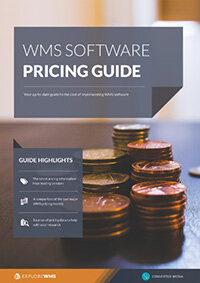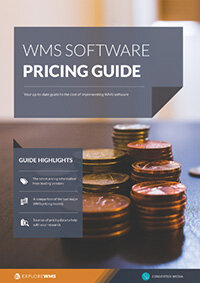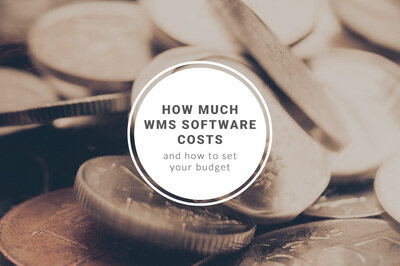10 steps to conducting a WMS cost benefit analysis
A cost-benefit analysis is a systematic way to determine the right option for you to reach a specific task, adopt a system, or meet some other functional business element. In the case of a WMS, it’s often used to see if a new platform will save money or meet some kind of larger operational efficiency goals.
Different CBA skeletons will have different steps and processes, so we’ve put together a model that should help you get started when considering your WMS, helping you determine if your decision will be sound and to give you a baseline to compare options or other projects.
1. Describe your planned system and existing alternatives
List out the features of the WMS you’re considering and if these are present in your warehouse already. This is your chance to describe how the WMS will change your operations, such as automating the delivery of picking lists for staff or automatically performing inventory checks so that you no longer need to do one at the end of each shift.
2. List stakeholders involved in purchase and use
Today’s WMS options use a lot of data and interact with many different processes. Consider every area where this occurs, from your billing department and customer relationship team to how an individual will use the system to find stock or input a trouble ticket. You want to determine the entire audience to see if you can provide value to each of them.
3. Define your measurements
The goal of a WMS purchase is usually to save time and money. Figure out how you want to define these, such as reduced hours per team or quarter, your currency, and reduced time for tasks. Defining things here is just to keep your records straight as you review changes. It can mess up your entire CBA if you record a “1” for time saved picking to represent one minute but a “1” for total order prep time to mean you saved an hour.
Get up-to-date info on how much WMS costs with this comprehensive WMS pricing guide
4. Define and itemize tangible and intangible costs
Look at every step of purchasing and implementing your new system. Tangible costs are your monthly costs, supplies, new hardware, licensing fees, and similar costs. Intangible are your estimates for things like the cost of the time you spend on implementation, the energy it takes to learn a new system, changes in profitability as your team learns new processes and creates a new routine, and any potential losses to business during implementation. If your order platform doesn’t work with the WMS, for example, you may have to change that system too or pay someone to build you a custom integration, which will take both time and money.
5. Create a list of projected benefits
Like you did with costs, try to create a complete list of potential benefits, and itemize them to determine the value. For your WMS, look at operational benefits, options like analytics modules that can give you better layouts in the warehouse, tools that automate checks and audits, reduced processes, and even areas where you may need fewer staff members. Think of income you’ll make or save, time and effort you can reduce or optimize, and if it has the potential to generate repeat customers or otherwise improve those relationships.
6. Make outcome predictions about both cost and benefits over your timeframe
Here’s your homework time. You’ll have to study your warehouse and the system you want to use to see if you’re going to be a success. Turn to case studies or ask the WMS provider for customer referrals that look like your business. See what they were able to do and which systems were beneficial. Measure these wins against the costs that you expect.
7. Convert all costs and benefits into a common unit
How much does a 10% increase in warehouse productivity impact your revenue? What’s the practical application of each step in terms of daily costs and overall revenue or profit generation?
You need everything in the same unit for the final analysis, so it’s a heavy math time as you convert hours saved, operational gains, and the time that you’re losing for training all into currency amounts.
8. Determine value and payback time
Now that everything is converted to your currency, map out costs over your total timeframe. Do the same for your benefits and compare — and be sure to note that benefits will likely start months after costs do. Track the trends and look at how long it’ll take you to make your money back.
If you’re not hitting a positive ROI in your timeframe, you’ll need to circle back with leadership and see if the timeframe should be extended or if you need a new option.
9. Perform sensitivity analysis.
Sensitivity analysis is a way to review the mathematical system that you’ve used to calculate costs and potential profits. It’s extremely important to use because it can help determine if you got all the numbers in Step 7 correct.
There are a variety of sensitivity analysis models and techniques. A consultant familiar with the WMS space might be your best bet to verify your models and ensure you’re staying accurate with your predictions.
10. Create a recommendation and adopt it
After all that analysis is complete, it’s time to make your recommendation based on gains, losses, and the time to establish the ROI you want. Return to your stakeholders list and make sure the recommendation talks to each of them and is compelling. Once they sign off, it’s time to put your WMS into place.
A CBA is a long and complex process, but when it comes to saving or costing you thousands of dollars, it’s a worthwhile investment.
Free white paper

WMS software pricing guide
Your up-to-date guide to the cost of WMS software

Related articles
-

How much WMS software costs and how to set your budget
A complete guide to WMS costs, and how to calculate your budget based on these
-

Mission-critical features of food lot traceability software
What features of food traceability software will help you during a food recall
-

What are the biggest WMS challenges in warehouse management?
The top problems warehouses face and how WMS helps them

